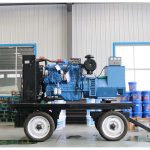Diesel Generators for Emissions Control A Comprehensive Guide

Introduction
Diesel generators are widely used in various industries and applications to provide backup power during outages or as the main power source in remote locations. While diesel generators are known for their reliability and efficiency, they are also notorious for their emissions of harmful pollutants such as nitrogen oxides (NOx), particulate matter (PM), and carbon monoxide (CO). In recent years, there has been a growing awareness of the environmental impact of diesel generator emissions, leading to increased regulations and a focus on emissions control technologies.
This article aims to provide a comprehensive guide to diesel generators for emissions control, including an overview of the emissions produced by diesel generators, the regulations governing emissions, and the various technologies and strategies available to reduce emissions from diesel generators.
Emissions from Diesel Generators
Diesel generators are internal combustion engines that burn diesel fuel to produce electricity. During the combustion process, various pollutants are produced and emitted into the atmosphere. The main pollutants emitted by diesel generators include:
1. Nitrogen oxides (NOx): NOx is a group of gases that includes nitric oxide (NO) and nitrogen dioxide (NO2). 150kw diesel generator are a significant contributor to air pollution and can have harmful effects on human health and the environment. NOx is formed during the high-temperature combustion process in diesel engines.
2. Particulate matter (PM): PM consists of tiny particles of solid or liquid matter suspended in the air. PM emissions from diesel generators can include soot, ash, and other fine particles. PM can have adverse health effects, particularly on the respiratory system, and can contribute to haze and reduced visibility.
3. Carbon monoxide (CO): CO is a colorless, odorless gas that is produced during incomplete combustion of fuel. CO emissions from diesel generators can pose a risk to human health, as high levels of CO can impair the body's ability to transport oxygen to vital organs.
Regulations Governing Emissions from Diesel Generators
In response to the environmental and health impacts of diesel generator emissions, governments around the world have implemented regulations to limit the emissions of pollutants from diesel generators. These regulations typically set emission standards that diesel generators must meet to be compliant. Some of the key regulations governing emissions from diesel generators include:
1. United States Environmental Protection Agency (EPA) Regulations: In the United States, the EPA sets emission standards for stationary diesel engines, including diesel generators. The EPA's regulations are aimed at reducing emissions of NOx, PM, and other pollutants from diesel generators to protect air quality and public health.
2. European Union (EU) Emissions Standards: The EU has established emissions standards for diesel engines, including those used in diesel generators. The EU's regulations set limits on the emissions of NOx, PM, CO, and other pollutants from diesel generators to reduce air pollution and protect the environment.
3. International Maritime Organization (IMO) Regulations: The IMO has established regulations to control emissions from diesel engines used in marine applications, including shipboard generators. The IMO's regulations aim to reduce emissions of pollutants such as NOx, PM, and sulfur oxides (SOx) from diesel generators on ships to minimize their impact on the marine environment.
Technologies and Strategies for Emissions Control
To comply with emissions regulations and reduce the environmental impact of diesel generators, various technologies and strategies are available for emissions control. These technologies can be broadly categorized into engine modifications, exhaust aftertreatment systems, and alternative fuels. Some of the key technologies and strategies for emissions control in diesel generators include:
1. Selective Catalytic Reduction (SCR): SCR is an exhaust aftertreatment technology that uses a catalyst to convert NOx emissions into nitrogen gas and water vapor. SCR systems are effective at reducing NOx emissions from diesel generators and are commonly used to meet emissions standards.
2. Diesel Particulate Filters (DPF): DPFs are devices that capture and remove particulate matter from the exhaust stream of diesel generators. DPFs use a porous ceramic or metal filter to trap PM particles, preventing them from being released into the atmosphere.
3. Exhaust Gas Recirculation (EGR): EGR is an engine modification technology that recirculates a portion of the engine's exhaust gas back into the combustion chamber. EGR reduces the formation of NOx emissions by lowering the combustion temperature in the engine.

4. Oxidation Catalysts: Oxidation catalysts are catalytic converters that use a chemical reaction to convert CO and hydrocarbons in the exhaust gas of diesel generators into less harmful substances such as carbon dioxide and water vapor.
5. Biofuels: Biofuels are renewable fuels derived from biomass sources such as plant oils, animal fats, and waste materials. Using biofuels in diesel generators can reduce the emissions of greenhouse gases and other pollutants compared to conventional diesel fuel.
6. Hybrid Systems: Hybrid systems combine diesel generators with other power sources such as batteries or renewable energy sources to reduce fuel consumption and emissions. Hybrid systems can improve the efficiency of diesel generators and lower their environmental impact.
Conclusion
Diesel generators play a crucial role in providing reliable power in various applications, but they also have significant environmental impacts due to their emissions of pollutants such as NOx, PM, and CO. To address these environmental concerns, regulations have been implemented to limit emissions from diesel generators, and a range of technologies and strategies are available for emissions control.
By adopting emissions control technologies such as SCR, DPF, EGR, oxidation catalysts, biofuels, and hybrid systems, diesel generator operators can reduce their environmental footprint and contribute to a cleaner and healthier environment. As the demand for clean and sustainable power sources continues to grow, the development and adoption of emissions control technologies for diesel generators will play a crucial role in mitigating the environmental impact of these essential power sources.
